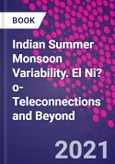Indian Summer Monsoon Variability: El Ni�o-Teleconnections and Beyond presents the improved understanding of Indian Monsoon teleconnections (ENSO and Non-ENSO), new advances, and preferred future steps. Special emphasis is given to non-ENSO teleconnections which have been poorly understood for decades. With growing monsoon rainfall extremes across the Indian Subcontinent, a new understanding of monsoon environmental factors that are driven remotely through teleconnections is a trending topic. Finally, the book reviews current understanding of the observational and modeling aspects of Indian monsoon teleconnections. This is a must-read for researchers and graduate students in atmospheric science and meteorology.
Please Note: This is an On Demand product, delivery may take up to 11 working days after payment has been received.
Table of Contents
1. Drivers of the Indian Summer Monsoon Climate Variability2. Interannual variation of the Indian summer monsoon, ENSO, IOD and EQUINOO
Part I. ENSO-Indian Summer Monsoon teleconnections
3. ENSO-Indian Summer Monsoon Teleconnections
4. ENSO Modoki teleconnections to Indian Summer Monsoon rainfall
A review
5. The decaying phase of El Ni?o and Indian summer monsoon rainfall
6. El Nin?o - Indian summer monsoon relation
A non-linear scale interactive energy exchange perspective
7. Teleconnection between the Indian summer monsoon and climate variability: a proxy perspective
Part II. Indian and Atlantic Ocean
Indian Summer Monsoon teleconnections
8. Indian Ocean Dipole influence on Indian summer monsoon and ENSO
A review
9. Influence of Southern Tropical Indian Ocean Rossby waves on Indian Summer Monsoon
10. Atlantic Nino
Indian Summer Monsoon teleconnections
11. Teleconnections between Tropical SST modes and Indian Summer Monsoon in Observation and CMIP5 models
Part III. Subtropical and Extratropical teleconnections to Indian Summer Monsoon
12. Eurasian Snow and Asian Summer Monsoon
13. Coupling of the Indian, western North Pacific and East Asian summer monsoons
14. Teleconnection along the Asian jet stream and its association with the Asian summer monsoon
15. South Asian summer monsoon and subtropical deserts
16. Interaction between South Asian High and Indian Summer Monsoon rainfall
17. Southern Annular Mode teleconnections to Indian Summer Monsoon
18. The Atlantic Multidecadal Oscillation and Indian Summer Monsoon Variability: a Revisit
19. Indian Summer Monsoon and Its Teleconnection with Pacific Decadal Variability
Part IV. Climate change and Monsoon teleconnections
20. Future changes of the ENSO-Indian Summer Monsoon teleconnection
21. Response of the positive Indian Ocean Dipole to climate change and impact on Indian summer monsoon rainfall
22. South Asian Summer Monsoon response to anthropogenic aerosol forcing
23. Moisture recycling over the Indian monsoon core region in response to global warming from CMIP5 models








